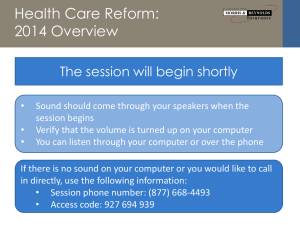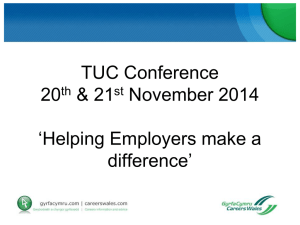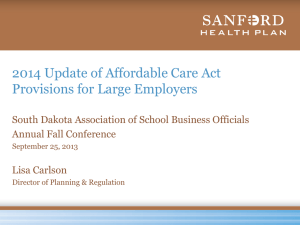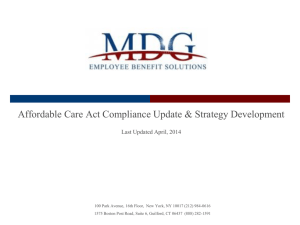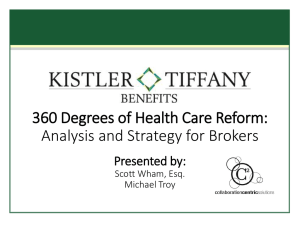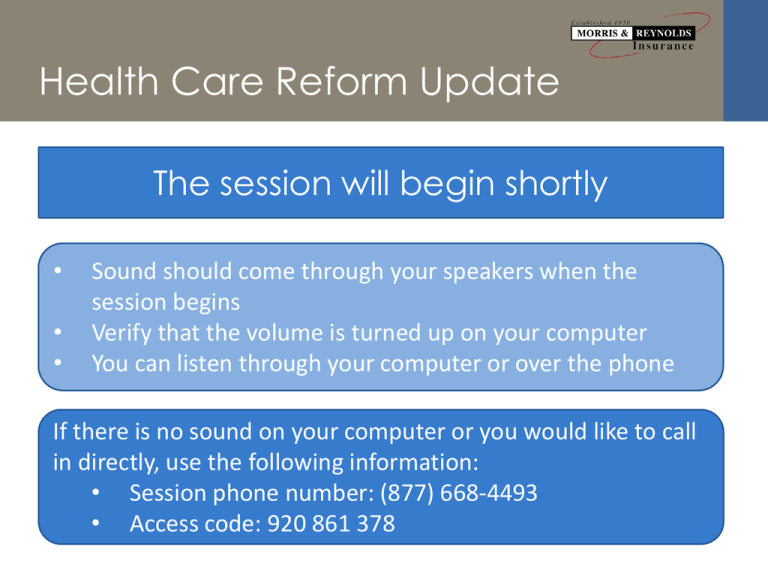
Health Care Reform Update
The session will begin shortly
•
•
•
Sound should come through your speakers when the
session begins
Verify that the volume is turned up on your computer
You can listen through your computer or over the phone
If there is no sound on your computer or you would like to call
in directly, use the following information:
• Session phone number: (877) 668-4493
• Access code: 920 861 378
Health Care
Reform Update
April 2014
Presented by: Erica Storm, Esq.
Becca Kopps, Esq.
Robert D. Reynolds, CIC, CPIA, AAM, AIS, AU
Introduction
About the presenters
Erica Storm, Esq.
Becca Kopps, Esq.
Robert D. Reynolds,
CIC, CPIA, AAM, AIS, AU
•
Employment and
benefits attorney
•
Employment and
benefits attorney
• President & CEO Morris
& Reynolds Insurance
•
Expertise in health
care reform and
health plan issues
•
Primary focus: health
care reform
•
Creates educational
materials and
compliance resources
• Insurance & Employee
Benefits Broker For Over
30 Years
•
Educates companies
on compliance
obligations
• Certified Healthcare
Reform Expert
Webinar Logistics
To call in to
connect to
audio:
We welcome your
questions at any
time!
Questions will be
addressed at the
end of the session.
•Phone number: 1-877-668-4493
•Access code: 920 861 378
Select Q&A and
choose “Send to All
Panelists” to submit
your questions.
Health Care Reform
Affordable Care Act
• Enacted in March 2010
• Implemented over several years
• Major changes for 2014 and 2015
Provisions that impact:
• Health care providers
• Government programs
• Health insurance issuers
• Employers/plan sponsors
• Individuals
Most employers that offer
health plans have been
impacted (and will
continue to be impacted)
Pay or Play Rules
Employer Shared Responsibility
Rules Effective Jan. 1, 2015
Penalties
may
apply:
Penalties
triggered
when:
• Employer does not offer coverage to
all FT employees (and children) OR
• Employer offers coverage to all FT
employees (and children) but
coverage is unaffordable or does not
provide minimum value
• Any FT employee gets a subsidy for
coverage through an Exchange
Rules apply to Applicable Large Employers: employed
50+ full-time employees during the prior calendar year
Potential Penalties
Penalty A (annual amounts)
• Employer did not offer coverage to substantially all
FT employees and dependents (children)
• $2,000 x (all FT employees – 30)
• Special rule for 2015
Penalty B (annual amounts)
• Employer offered coverage to substantially all FT
employees/dependents
• But not all employees, OR coverage is not
affordable or does not provide minimum value
• $3,000 x each employee who gets subsidized
coverage (capped at Penalty A amount)
Pay or Play Guidance
Jan. 2013
• Proposed pay or play regulations issued
July 2013
• Effective date for penalties and reporting
delayed until Jan. 1, 2015
Sept. 2013
• Proposed reporting regulations issued
(finalized in March 2014)
Feb. 2014
• Final pay or play regulations issued with
additional delays and transition relief
Pay or Play Rules: Mediumsized Employer Delay
One-year Delay for
Medium-sized Businesses
Applies to ALEs with fewer than 100 full-time employees
(including FTEs) on business days during 2014
• No 4980H penalties will
apply during 2015
• For non-calendar year
plans, includes the portion
of the 2015 plan year that
is in 2016
• Eligibility conditions apply
Eligibility for Transition Relief
Employers that change plan years after Feb. 9, 2014 to begin on
a later calendar date are not eligible for the delay
Maintenance of
Workforce and
Hours of Service
•May not reduce workforce size or hours of service
Feb. 9-Dec. 31, 2014 to qualify based on size
•Changes for bona fide business reasons permissible
Maintenance of
Previously Offered
Coverage
•May not eliminate or materially reduce coverage
offered as of Feb. 9, 2014 during maintenance
coverage period
Certification of
Eligibility
•Must certify that it meets all eligibility requirements
•Certification form aligned with employer reporting
requirements
Pay or Play Rules: Extended
Transition Relief
Determining ALE Status for 2015
Proposed
rule:
• Can measure number of FT
employees for any consecutive
6-month period in 2013 (instead
of the full 12 months) for 2014
Final rule:
• Can determine ALE status by
reference to a period of at least
six consecutive calendar
months in 2014 (for 2015)
Seasonal
worker
exception
• Will be determined based on
entire calendar year
Non-Calendar Year Plans
Can delay compliance until the 2015 plan year
• Conditions must be met
• Final rules extend 2014 transition relief and expand conditions so
that more employers are eligible
Transition relief tests related to:
• Pre-2015 eligibility
• Significant percentage of all employees
• Significant percentage of full-time employees
To qualify:
• Must have a non-calendar year plan as of Dec. 27, 2012
• May not have modified the plan year after Dec. 27, 2012 to start
at a later date
Transition Relief Conditions
Pre-2015 Eligibility
• Applies for
employees who
would be eligible
for coverage on
the first day of the
2015 plan year
• Under the eligibility
terms in effect on
Feb. 9, 2014
Significant % of all
Employees
Significant % of FT
Employees
• Must have covered
at least ¼ of
employees as of
any date in the 12month period
ending Feb. 9, 2014
OR
• Must have covered
at least 1/3 of fulltime employees as
of any date in the
12-month period
ending Feb. 9, 2014
OR
• Must have offered
coverage to at
least 1/3 of
employees during
the most recent
open enrollment
period before Feb.
9, 2014
• Must have offered
coverage to at
least ½ of full-time
employees during
the most recent
open enrollment
period before Feb.
9, 2014
Coverage for Dependents
ACA: to avoid penalties, ALEs must offer coverage to full-time
employees and dependents
2015 Relief
For employers
that:
• No penalties for
employers that
take steps
during the 2014
and/or 2015
plan years to
offer
dependent
coverage
• Do not offer
dependent
coverage
• Offer dependent
coverage that is
not MEC
• Offer dependent
coverage to some
but not all
dependents
Limits
• Relief is not
available if
coverage was
offered in 2013
or 2014 and
later dropped
Pay or Play Rules: New Rules
for 2015
“Substantially All” Full-Time
Employee Percentage
Employers still exposed to lesser penalties if coverage is not
offered to all full-time employees
4980H(a) Penalty Calculation
2015: ALEs with 100+ full-time employees can reduce fulltime employee count by 80 when calculating the penalty
Annual Penalty Calculation
• $2,000 x (all full-time employees minus 80)
Applies for:
• 2015
• Months of 2016 in the 2015 plan year
Pay or Play Rules:
Determining Full-time
Employee Status
How to Determine Full-time Status
Full-time Employee: for any month, an employee
who is employed on average at least 30 hours of
service per week (or 130 hours per month)
Two
methods
Employer
choice
•Monthly measurement method
•Look-back measurement
method
•May apply either monthly
measurement method or lookback measurement method
based on permitted categories
of employment
Permitted Employee Categories
Collectively
bargained vs.
noncollectively
bargained
Hourly vs.
salaried
employees
Different
groups of
collectively
bargained
employees
(separate
CBAs)
Employees
whose primary
places of
employment
are in different
states
Monthly Measurement Method
•
Used to identify full-time employees by employers who
do not use the look-back measurement method
•
Employees are identified based on the hours of service
for each calendar month
•
Employer must offer coverage to an employee by the
end of three full calendar months beginning with the
month the employee is otherwise eligible for coverage to
avoid penalties
•
Must be treated as returning employee unless there is a
13 week break in service or 4 week break in service that is
longer than the prior period of employment
Look-back Measurement Method
•
•
•
May be used for new variable
hour and seasonal employees
IF used for ongoing employees
Generally may not use the
look-back measurement
method for variable
hour/seasonal employees and
use monthly measurement
method for employees with
predictable schedules
Transition measurement
periods allowed for 2014
Measurement Period
Counting hours of service (3-12 months)
Administrative Period
Time for enrollment/disenrollment
(Up to 90 days)
Stability Period
Coverage provided (or not) – same
length for new and ongoing employees
Transition Measurement
Periods for 2015 Stability Periods
•
Proposed look-back measurement method included
in final regulations for determining full-time employee
status
•
Employers can use a shorter standard measurement
period in 2014 for a stability period beginning in 2015
•
Transition measurement period must:
− Be at least 6 but shorter than 12 consecutive months
− Begin no later than July 1, 2014 and end no earlier than 90
days before the 2015 plan year
Measurement
Period
Administrative
Period
Stability
Period
Look-Back Measurement
Method for Ongoing Employees
2013
Nov. 1
Dec. 31
Measurement Period
2014
Jan. 1
Nov. 1
Measurement Period cont.
Dec. 31
Admin Period
2015
Dec. 31
Jan. 1
Stability Period
Transition Measurement
Period for Ongoing Employees
Jan 1, 2014
April 1
Nov. 1
Transition SMP
Jan 1, 2015
Dec 31
Admin Period
Dec 31
Stability Period
Offering Coverage to New
Employees
New employees expected to work full-time
• Reasonably expected at start date to work full-time (not
seasonal)
• Offer coverage by end of first 3 full calendar months of
employment
New variable hour employees
New seasonal employees
New part-time employees
• Can measure using an Initial Measurement Period
• Offer coverage if full-time during IMP
Employer Reporting
Requirements
Section 6056 Reporting
Section 6056
• Applicable large employers must provide information
regarding coverage offered in the prior year
• File information returns with the IRS
• Provide employee statements to each full-time employee
• Final rules issued in March
Purpose of reporting
• Promote transparency of coverage and costs
• Assist IRS with ACA enforcement
Separate but related rules apply to self-insured plan sponsors
and health insurance issuers
Deadlines
•
Rules effective for 2015 coverage (2016 reporting)
•
General rules:
− Employee statements due by Jan. 31 of the following year
− IRS returns due by Feb. 28 of the following year
(March 31 if filed electronically)
•
2016 dates:
− Employee statements:
Feb. 1, 2016
− IRS returns: March 1, 2016
(or March 31 for electronic filing)
Required Information
IRS Return
• Employer contact
information
• Whether coverage was
provided to FT
employees/dependents
(by month)
• Number of FT
employees (by month)
• Specific employee
information
Employee Statement
• Employer contact
information
• Information shown on IRS
return related to that
employee
• Months coverage was
available
• Share of lowest-cost monthly
premium offered
• Months covered by
employer plan
How to Report
•
General Reporting Method
− File Form 1094-C (transmittal) and Form 1095-C (employee
statement) or substitute form with same information
− Provide copy of Form 1095-C or substitute form with same
information
− Will use indicator codes for reporting some information
•
Alternative Methods (optional)
•
Medium-sized Employers
•
Electronic filing required for employers filing 250+ returns
− Details to be provided in forms and instructions
− Available for specific groups of employees
− Must still report for 2015
− Must certify that they meet requirements for delay
90-Day Waiting Period Limit
General Rules
A group health plan may not impose any waiting
period that exceeds 90 days
Definition
• The period of time
that must pass before
coverage becomes
effective for an
employee or
dependent who is
otherwise eligible to
enroll in the plan
Effective date
• 2014 plan year
• Final regulations
issued in Feb. 2014
• May rely on proposed
regulations for 2014
Permissible Eligibility Conditions
Examples
• Being in an eligible job classification (may measure new variablehour employees for full-time status)
• Achieving job-related licensure requirements specified in plan terms
• Cumulative hours of service rule (up to 1200 hours, one-time only)
• Satisfaction of a reasonable and bona fide employment based
orientation period
Reasonable and bona fide employment-based
orientation period
• Employer/employee can evaluate whether situation is satisfactory
• Standard orientation and training processes would begin
• Maximum length of one month (proposed)
Anti-Abuse Rule
•
Cannot use eligibility conditions or take actions that
are a subterfuge to avoid compliance with the 90day limit
•
If no subterfuge, can require a terminated and
rehired employee to satisfy eligibility conditions
again
•
Same analysis applies to employee who moves to a
job classification that is ineligible for coverage under
the plan but then later moves back to an eligible job
classification
Individuals Currently in a
Waiting Period
Individuals in a waiting period when the rule becomes effective:
the waiting period can no longer apply to the individual if it
would exceed 90 days
Example
A calendar year plan
has a 6-month waiting
period for FT
employees prior to
Jan. 1, 2014.
Employee A begins
work as a full-time
employee on Oct. 1,
2013.
The first day of A’s
waiting period is Oct.
1, 2013.
A must be given the
opportunity to elect
coverage that begins
no later than Jan. 1,
2014, (which is 93 days
after A’s start date).
If not, on Jan. 1, 2014,
the plan would be
applying a waiting
period that exceeds
90 days.
40
Cost-Sharing Limits
Small Group Deductible
Limit Repealed
ACA Rule
• Small group insured health plans
subject to annual deductible limit
beginning with 2014 plan year
2014 limits
• $2,000 single coverage
• $4,000 family coverage
Exception
• Many insurers took advantage of an
exception permitting higher
deductibles for 2014
Repealed
April 1
• Protecting Access to Medicare Act of
2014
• Retroactively effective to March 23,
2010
Out-of-Pocket Maximum Limit
Applies to ALL non-grandfathered group health plans
beginning with 2014 plan year
Annual limits to increase each year:
2014:
2015:
$6,350 for single coverage $6,600 for single coverage
$12,700 for family
coverage
$13,200 for family
coverage
Special Rules for OOP Maximum
For 2014, plans with multiple service providers will satisfy
the limit if they:
• Comply with the out-of-pocket maximum limit for major medical
coverage AND
• Comply with the out-of-pocket maximum limit for any other
coverage with an out-of-pocket maximum
Clarifications for 2015 plan year:
• Must have OOP max on all essential health benefits (no limitation
required for non-EHBs)
• May use separate OOP limits for different categories of benefits if
they do not exceed overall annual limit
• Plans may count spending for out-of-network items and services
toward OOP limit
Upcoming Changes
SHOP Exchange
•
Small Business Health Option Program (SHOP) – Exchange
for small employers
2014-15
• States can
limit size to
up to 50
employees
•
2016
• States must
increase
size to up
to 100
employees
2017
• States can
let any size
employer
participate
Small employers can offer employees enrollment in a QHP
through a SHOP
− Can offer benefits through a cafeteria (Section 125) plan
− Exchange sets contribution methods
Exchange Enrollment
Enrollment opportunities differ for individuals and
small employers
Individuals
Small Employers
• Initial open enrollment:
Oct. 1, 2013-March 31,
2014
• Can buy coverage for
employees any time after
Oct. 1, 2013
• Annual open enrollment
delayed for 2015
coverage:
• Nov. 15, 2014-Jan. 15,
2015
• Oct. 15-Dec. 7 for later
years
• 12 month plan year and
annual election periods
required
• Online enrollment delayed
in FF-SHOPs until late 2014
(does not impact state-run
SHOP)
47
SHOP Timeline for Employers
Employer’s plan year
12-month period
Beginning with
effective date of
coverage
Annual employer election period
Annual employee
Employer gets notice election period
90 days before end
of plan year
Has 30 days to
change SHOP plan
Plan will continue if
no changes made
30 day period after
employer election
period
Employees can
change elections or
plans
Nondiscrimination Rules for
Fully Insured Health Plans
ACA:
Nondiscrimination
rules:
• Non-grandfathered fully insured
health plans must comply with
nondiscrimination rules
• Similar to rules for self-funded plans
• Prohibit discrimination in favor of highlycompensated individuals
2010:
• IRS delayed rules indefinitely,
pending issuance of regulations
2014:
• IRS confirmed that rules will not be
enforced this year due to prior delay
Automatic Enrollment
Applies to large employers that:
• Have more than 200 full-time employees
• Are subject to the FLSA
• Offer health coverage
Requirement:
• Must automatically enroll new employees (and re-enroll
current employees) in one of the employer’s health plans
• Subject to any permissible waiting period
Effective date:
• Rules will be applicable after final regulations are issued
Cadillac Tax
40% excise tax
• On “high-cost” group health coverage
• Applies to “excess benefit” of each employee’s aggregate
employer-sponsored coverage over annual limitation
Annual limitation for employees:
• $10,200 for single coverage
• $27,500 for family coverage
• Higher limits for retirees and high-risk professions
Applies for taxable years beginning in 2018
• Employers must calculate and report tax
• Coverage provider must pay tax
Questions?
For more information about Health Care Reform visit: www.morrisandreynolds.com/health-reform/
Morris & Reynolds Insurance
14821 South Dixie Highway, Miami, FL 33176
Telephone 305.238.1000 | Fax 305.255.9643
Thank you!
This presentation is current as of the date presented and is for informational purposes only. It is not intended to be
exhaustive nor should any discussion or opinions be construed as legal advice. Please contact legal counsel for legal advice on
specific situations. This presentation may not be duplicated or redistributed without permission. © 2012-2014 Zywave, Inc.
All rights reserved.




